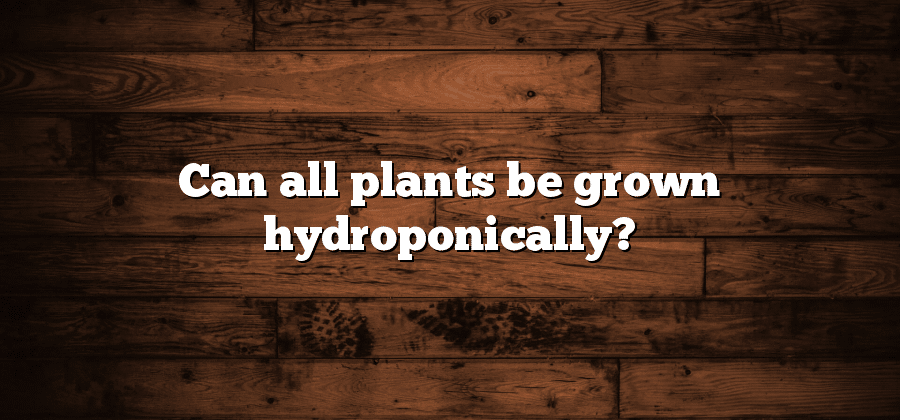– Selecting Quality Seeds or Seedlings
Quality seeds or seedlings are the foundation of a successful hydroponic garden. When selecting seeds or seedlings for your hydroponic system, there are several factors to consider. First, prioritize seeds or seedlings from reputable suppliers who specialize in hydroponics. These suppliers have a better understanding of the specific needs of hydroponic plants and are more likely to provide high-quality options.
In addition, look for seeds or seedlings that are disease-resistant and well-suited for hydroponic growing conditions. This includes plants that have been specifically bred for hydroponic systems. Pay close attention to the germination rate and opt for seeds or seedlings with a higher rate to ensure maximum success. Finally, choose seeds or seedlings that are appropriate for the space and resources available in your hydroponic setup. Consider factors such as the type of system you are using, the amount of light available, and the types of nutrients you will be using. By selecting quality seeds or seedlings, you will lay the groundwork for a thriving hydroponic garden.
– Maintaining System Cleanliness
Keeping a hydroponic system clean is essential for the optimal growth of plants and the prevention of diseases. Regular cleaning and maintenance not only remove debris and dirt but also help to prevent the build-up of harmful bacteria and pathogens. A dirty system can hinder nutrient absorption and lead to the development of pests, which can ultimately affect the overall health and productivity of the plants. Therefore, it is crucial to develop a systematic cleaning routine to ensure the longevity and success of your hydroponic system.
To maintain cleanliness, start by regularly inspecting the components of your hydroponic system. This includes checking the nutrient reservoir, tubing, and irrigation system for any signs of algae, sediment, or blockages. Cleaning these areas may involve draining and disinfecting the reservoir, flushing the tubing with a water and vinegar solution, and scrubbing any surface that has been contaminated. Additionally, ensure that any tools or equipment used, such as pruning shears or pH meters, are properly cleaned and disinfected after each use. By following these practices, you can create a clean and sanitary environment that promotes healthy plant growth in your hydroponic system.
– Ensuring Adequate Lighting and Nutrient Delivery
Proper lighting and nutrient delivery are vital aspects of a successful hydroponic system. Adequate lighting ensures that plants receive the right amount and quality of light they need for photosynthesis. LED lights are commonly used in hydroponic setups due to their energy efficiency and ability to provide specific light wavelengths. However, it is important to choose the right type of LED lights that cater to the specific needs of the plants being grown.
In addition to lighting, providing plants with the necessary nutrients is crucial for their healthy growth. Hydroponic systems allow for precise nutrient delivery, ensuring that plants receive the required amount of essential elements. Nutrient solutions can be formulated specifically for different types of plants, taking into consideration their growth stage and nutritional requirements. It is essential to monitor and adjust the nutrient solution regularly to ensure that plants are receiving a well-balanced diet for optimal growth and productivity.
Exploring Alternative Hydroponic Techniques
As the popularity of hydroponic gardening continues to grow, so does the exploration of alternative techniques within this innovative practice. One such technique gaining attention is known as aeroponics. Unlike traditional hydroponics, aeroponics involves suspending plant roots in a highly oxygenated mist, allowing them to absorb nutrients directly from the air. This technique offers several advantages, including faster growth rates, increased yields, and the ability to cultivate crops in a smaller space. Additionally, aeroponics reduces the risk of disease and eliminates the need for any growing medium, making it a highly efficient and sustainable option for hydroponic gardening.
Another alternative technique worth considering is nutrient film technique (NFT). In NFT systems, a thin film of nutrient-rich water continuously flows over the roots of the plants, providing them with a steady supply of essential elements. This technique is particularly suitable for plants that have shallow root systems, such as lettuce and herbs. NFT systems are low maintenance, require less water compared to other hydroponic methods, and promote good oxygen circulation. By exploring these alternative hydroponic techniques, growers can expand their knowledge and potentially discover new ways to enhance productivity and efficiency in their gardening endeavors.
– Aeroponics
Aeroponics is a cutting-edge technique that offers numerous advantages for growing plants hydroponically. Unlike other methods, aeroponics does not involve the use of soil or any growing medium. Instead, plants are suspended in air and their roots are misted with a nutrient-rich solution. This allows for optimal oxygenation and nutrient absorption, leading to faster growth rates and higher yields. Additionally, aeroponics eliminates the risk of soil-borne diseases and pests, as well as the need for excessive water usage. With its ability to maximize resources and enhance plant health, aeroponics is gaining popularity among both commercial growers and hobbyists alike.
One of the key benefits of aeroponics is the accelerated growth rate it provides. By directly misting the plant’s roots with a nutrient solution, aeroponics ensures that the plants receive a constant and balanced supply of nutrients. This allows the plants to focus their energy on vegetative growth and development, resulting in healthier and more robust plants. Moreover, the increased oxygenation in an aeroponic system promotes the growth of larger root systems, which further enhances nutrient uptake and plant vitality. With this innovative technique, growers can achieve remarkable results in a short span of time, making aeroponics a game-changer in the realm of hydroponic cultivation.






